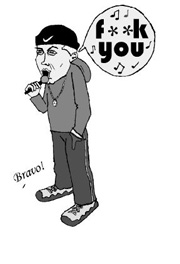IT WAS A MOMENTARY story on the evening news, a photo in the paper, and then gone: last week’s student anti-war protest, in which some 500 or so mostly high-school-age students walked out of classes and marched—to Seattle Central Community College from Garfield High School and Nova and the University of Washington, and from Capitol Hill to downtown and back. The stories were perfunctory: a quote from a student protester, a quote from a student who disagreed, a quick scold from the school district. And on to the next story.
But last Thursday’s protest, organized and carried out almost entirely by people under the age of 20, was something much more. It was a moment of great hope.
Missed in the by-the-numbers news coverage was the remarkable nature of the protest itself, how the students carried themselves, how the public and even the police responded. It was a protest unlike any Seattle has seen in years. And, frankly, it was a shame that so few adults, especially adults inclined to anti-war agitation themselves, were present. Among the perhaps dozen of us codgers there—a nearby office worker, a handful of activists who’d gotten wind of it, a mom who got a midday phone call (“Hi, Mom! Guess what? I’m not in school. I’m marching downtown!”)—the consensus was twofold: It was a fundamentally different kind of event, and adult activists could have learned a lot.
THE CONTRAST WITH the previous weekend’s N-30 anniversary protest was stark. Despite strenuous efforts by organizers to shift the focus away from street confrontation, which made the Nov. 30, 1999, World Trade Organization protest famous, and to community service, the very monikers “N-30” and “WTO” simply carry too much baggage for too many people.
The biggest difference in Thursday’s event, of course, was its very nature: Any crowd of teens is very different from any crowd of adults. It meant an infectious energy, anger mixed with naﶥt頭ixed with joy, which carried over into everything from the speed of the march (about double the usual protester shuffle) to the creativity and unflagging energy of the chants and whooping to—most important—the apparent complete lack of awareness that some people would disagree, that this wasn’t the most natural and all-American thing in the world to be doing: namely, setting aside one’s daily routine when important matters of the country and world demand that your concerns be heard.
With few exceptions, that’s also how they were received. Downtown shoppers, whose usual reactions to peace marches have been a mixture of cautious support for the sentiment (there’s far more agreement among Seattleites than many protesters suppose) and nervousness lest the shopper get gassed or catch protester germs. Instead, last week, it was as though onlookers saw the faces, saw the age of the marchers, and relaxed. These were not alien zombie radicals; these were kids, who looked perhaps a lot like their own kids, doing something that maybe they themselves once did. People smiled and waved and clapped and yelled encouragement. These weren’t troublemakers; they were good kids, the kids who care, who take their looming inheritance of our world seriously.
Even Seattle police—who, while notably more relaxed this year, are still wary of any protest—seemed to see in the crowd their own daughters and sons. They kept their visible numbers small and at ease; they kept protesters off the street without menacing phalanxes or using bicycles as weapons or harassing anyone who accidentally strayed off a curb.
And suddenly, it was fun for the protesters, no big deal for the public, and students’ concerns about the message itself could be heard without all the baggage of ideology or anti-cop or anti-protester attitude. It was, in that sense, a far more effective vehicle than the much larger anti-war marshaling of this autumn, which has resulted in fine, spirited affairs for participants but also very predictable events that did little to engage the general public.
AS FOR THE STUDENTS themselves, despite the inevitable school-district sniffing that students belonged “in class with their teachers,” this was both an application of their lessons and a lesson in itself. At Hazel Wolf High School, which had an all-day, schoolwide Iraq teach-in three days previous, one student guessed that “95 percent” of the school had hit the streets. This was class. It’s hard to imagine some 30-year-old veteran of these things uttering the exhortations of one student: “Show your colors! Stop the war! This is America! We are free! No war!“
When was the last time you heard anyone equate our country’s freedoms with the need not to fight war, to rise above our seemingly reflexive militarism? And why shouldn’t it be the most natural idea in the world?
Perhaps students, whose experience of the world comes out of the contrast between the evening news and their civics textbooks, have learned something the rest of us have forgotten.








